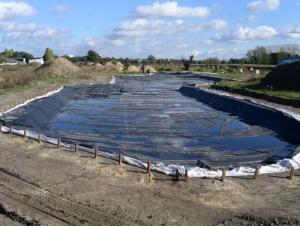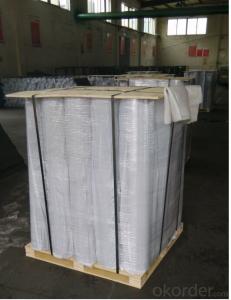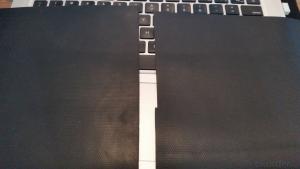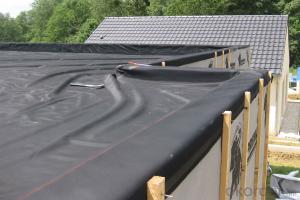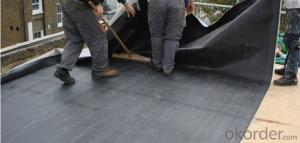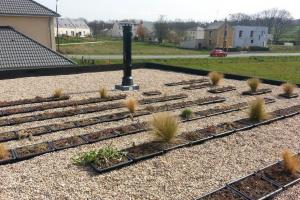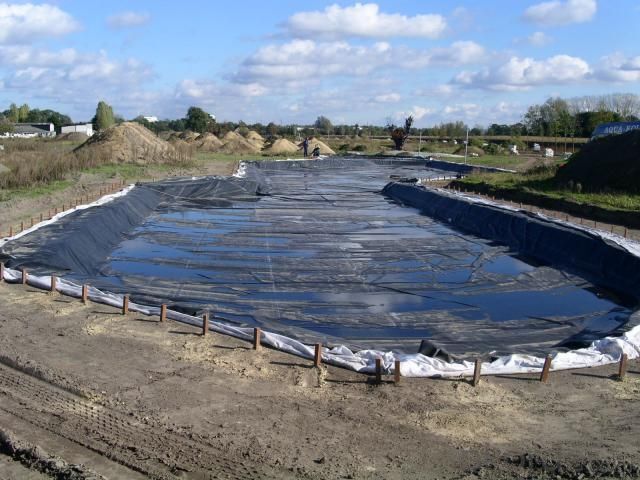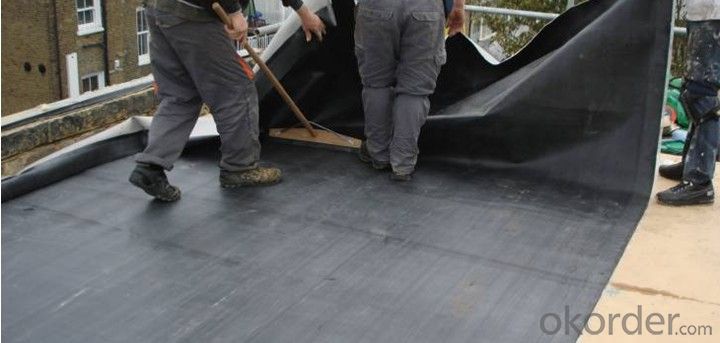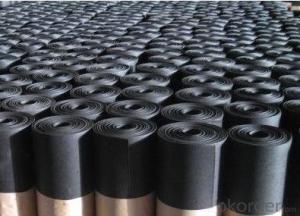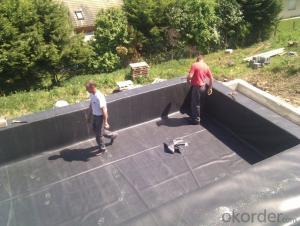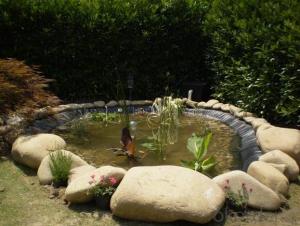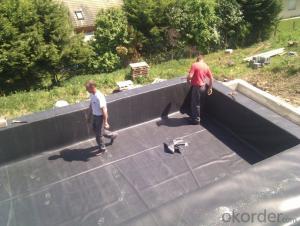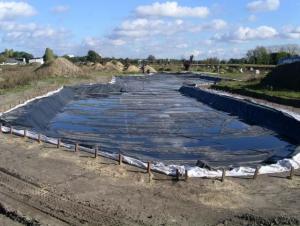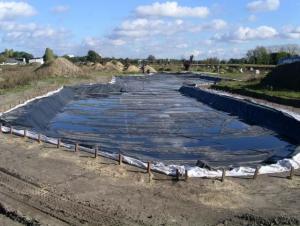EPDM Rubber Coiled Waterproof Membrane for Manmade Pond
- Loading Port:
- Shanghai
- Payment Terms:
- TT OR LC
- Min Order Qty:
- 50000 m²
- Supply Capability:
- 5000000 m²/month
OKorder Service Pledge
OKorder Financial Service
You Might Also Like
EPDM Rubber Coiled Waterproof Membrane for Manmade Pond
Description Of EPDM Rubber Coiled Waterproof Membrane for Manmade Pond:
•EPDM waterproof sheet has excellent anti-ozone-aging performance, able to resist ultraviolet light and corrosion of many chemical corrosive materials in the atmosphere
•It has high tensile strength, high ductility and strong retractility, it has excellent crack resistance, able to effect waterproof function even with tiny vibration of buildings.
• Excellent resistance to ozone, oxidation and sunlight.
• Resistance to chemicals; resistant to most inorganic products.
Main Features of EPDM Rubber Coiled Waterproof Membrane for Manmade Pond:
1>Excellent antiaging performance, service life up to 50 years
2>Working well with in 40C to 100C,it canbe constructed with a single layer in ambient temperature.
3>Waterproofing on various kinds of underground project,industrial of civil buildings and structures.
4>high extension rate, high tensile strength, small size changes at heat treatment
5>Good plant roots penetrability resistance and can be made waterproofing layer of planting roof
6>Special modified molecular structure ,effectively resolving the current domestic and foreign glue joint problem.
7>Good low temperature flexibility, and good performance of adapting to ambient temperature changes.
8>Convenient application ,solid joint, no environment pollution
9>chemical corrosion Resistance, can be used for special occasions
10>Convenient maitenance, low cost.
Specifications of EPDM Rubber Coiled Waterproof Membrane for Manmade Pond:
| Material | EPDM Rubber |
| Size | 1.2m (width)*20m (length) or customized, weldable type 2.05m or 4m width |
| Thick | 1.2mm, 1.5mm, 2.0mm |
| Type | Vulcanized & Weldable |
| Pattern | Non-reinforced (homogeneous) |
| Certificate | ISO9001/14001 |
Applications of EPDM Rubber Coiled Waterproof Membrane for Manmade Pond:
Widely used in roofs, basement, toilet ,swimming pool, and all kinds of industry and civil building waterproofing, reservoir, vivicism, bridge, underground, tunnel and dam waterproofing ,especially to the keystone waterproofing projects which is durability, high corrosion resistance and easy deformation.



IMages of EPDM Rubber Coiled Waterproof Membrane for Manmade Pond:




FAQ of EPDM Rubber Coiled Waterproof Membrane for Manmade Pond:
1. What are we supplying?
We are specialized in producing Colorful Asphalt Roof Shingle, SBS/APP modified bitumen waterproof membrane, Self adhesive bitumen waterproof membrane, PVC waterproofing membrane, EPDM rubber roofing membrane, Single Component Polyurethane Waterproof Coating, and Spray Polyurea Waterproof Coating
.
2. How Many years experience do we have?
We have been exported to more than 20 countries in the past 15 years.
3. How long do we usually reply your request?
We always reply our customer within 24 hours.
- Q: Are there different waterproofing membrane options for above-ground and below-ground applications?
- There is a variety of waterproofing membrane options available for above-ground and below-ground applications. When it comes to above-ground applications, structures like roofs, balconies, or walls require waterproofing. In these cases, commonly used membrane options include liquid-applied membranes, sheet membranes, and polyurethane membranes. These membranes are designed to withstand weather elements, such as UV rays, temperature changes, and foot traffic. On the other hand, below-ground applications involve waterproofing structures like basements, foundations, or tunnels. Below-ground waterproofing membranes are specifically designed to withstand hydrostatic pressure from the surrounding soil and groundwater. These membranes are typically thicker and more durable compared to above-ground membranes. Bituminous membranes, bentonite clay membranes, and composite membranes are commonly used options for below-ground waterproofing. Selecting the appropriate waterproofing membrane for each specific application is crucial due to varying requirements and challenges. Seeking advice from a waterproofing professional or engineer can assist in determining the most suitable membrane option for both above-ground and below-ground applications.
- Q: Are waterproofing membranes resistant to earthquake-induced water pressure?
- Yes, waterproofing membranes are designed to be resistant to earthquake-induced water pressure. These membranes are specifically engineered to provide a barrier against water infiltration, even under high-pressure situations caused by an earthquake.
- Q: Can a waterproofing membrane be used on both horizontal and vertical surfaces?
- Both horizontal and vertical surfaces can benefit from the use of a waterproofing membrane. These membranes have been specifically designed to create a barrier against water infiltration, regardless of the surface's orientation. They are widely used in a variety of applications, including roofs, foundations, basements, bathrooms, and swimming pools. Typically, these membranes are constructed using materials such as bitumen, rubberized asphalt, polyurethane, or PVC, which are highly resistant to water penetration. Whether it is a roof or a wall, a waterproofing membrane can effectively prevent water from seeping through and causing damage. However, it is crucial to ensure that the membrane is properly installed and adhered to the surface in order to achieve optimal waterproofing performance.
- Q: Can a waterproofing membrane be used on roofs with standing water or ponding?
- No, a waterproofing membrane should not be used on roofs with standing water or ponding. Standing water can put excessive stress on the membrane and compromise its effectiveness, leading to leaks and water damage. It is important to address and correct any ponding issues before applying a waterproofing membrane to ensure its long-term performance.
- Q: How does a waterproofing membrane handle construction vibrations?
- To withstand construction vibrations, a waterproofing membrane is created as a durable and flexible barrier. This membrane, typically composed of materials like rubberized asphalt or synthetic polymers, possesses remarkable elasticity and tensile strength. When construction vibrations occur, the waterproofing membrane absorbs and disperses them, safeguarding the building's structural integrity and the waterproofing system. The membrane's flexibility enables it to stretch and contract, accommodating the vibrations without experiencing cracks or tears. Moreover, certain waterproofing membranes include features like reinforced layers or fabric reinforcement, which augment their ability to endure construction vibrations. These reinforcements provide extra strength and stability, rendering the membrane more resistant to damage from vibrations. It is crucial to recognize that the effectiveness of a waterproofing membrane in handling construction vibrations is influenced by the quality of installation. Proper installation methods, encompassing adequate surface preparation and appropriate adhesion techniques, ensure that the membrane is securely affixed to the substrate, thereby minimizing the risk of displacement or damage during construction activities. In conclusion, a waterproofing membrane is specially designed to handle construction vibrations by absorbing and dispersing their impact, while maintaining its integrity and waterproofing capabilities. The membrane's flexibility and strength, combined with proper installation techniques, guarantee its ability to withstand the challenges posed by construction vibrations and provide enduring protection against water intrusion.
- Q: How do waterproofing membranes prevent water leakage?
- Waterproofing membranes function as a barrier between the surface and water, effectively preventing any leakage. These membranes, which can be made of bitumen, PVC, or EPDM, are typically applied in liquid or sheet form. The key mechanism by which waterproofing membranes halt water leakage is through the creation of a continuous and impermeable layer. This layer acts as a physical obstacle, preventing water from seeping through the surface. Moreover, the membranes are carefully applied to cover the entire surface, including joints, cracks, and seams, leaving no vulnerable areas for water penetration. Another important aspect of waterproofing membranes is their exceptional adhesive properties, enabling them to form a strong bond with the surface. This ensures that there are no gaps or spaces through which water can enter. Furthermore, by adhering firmly to the surface, the membranes also serve as a barrier against the movement of water vapor, effectively preventing moisture buildup and potential structural damage. Moreover, waterproofing membranes are specifically designed to offer high resistance to water and moisture. Their composition ensures that they do not degrade or deteriorate when exposed to water, guaranteeing their longevity and effectiveness. This resistance to water also prevents the membrane from becoming permeable over time. To sum up, waterproofing membranes effectively prevent water leakage by establishing a continuous and impermeable barrier on the surface. They cover the entire surface, adhere securely to eliminate gaps, and exhibit resilience against water and moisture. By implementing these measures, waterproofing membranes provide reliable protection against water infiltration and subsequent damage.
- Q: Can a waterproofing membrane be used on concrete tanks?
- Concrete tanks can indeed benefit from the use of a waterproofing membrane. The primary purpose of this membrane is to create a barrier that prevents water from penetrating through. It is specifically designed to be applied on various surfaces, including concrete. Waterproofing membranes are especially useful for concrete tanks that are used for water storage or containment. By applying the membrane on the concrete surface, a protective layer is formed that effectively stops water from entering or exiting the tank. This is crucial for maintaining the tank's structural integrity and avoiding any potential damage or contamination caused by water leakage. Furthermore, these membranes also offer protection against other substances that may be present in the tank, such as chemicals or pollutants. It is important to choose the right type of membrane that suits the specific requirements of the concrete tank. Following the manufacturer's instructions for application is also essential to ensure that the waterproofing is effective and long-lasting.
- Q: Is the waterproofing membrane an insulating material?
- 2, with a metal foil surface modified asphalt waterproofing membrane, in order to expose the use of extended durability period, the surface of the composite layer of metal foil.
- Q: Can a waterproofing membrane be used on tunnels with pedestrian traffic?
- Yes, a waterproofing membrane can be used on tunnels with pedestrian traffic. Waterproofing membranes are commonly used in tunnels to prevent water infiltration and damage. They can effectively protect the structure from moisture, ensuring the safety and durability of the tunnel, even with pedestrian traffic.
- Q: How does a waterproofing membrane handle joint movement?
- A waterproofing membrane is designed to accommodate joint movement by being flexible and elastic. It can stretch and contract along with the joints, ensuring that there are no gaps or cracks through which water can penetrate. This flexibility allows the membrane to maintain its integrity and effectiveness even when the structure experiences movement due to factors like temperature changes or settling.
Send your message to us
EPDM Rubber Coiled Waterproof Membrane for Manmade Pond
- Loading Port:
- Shanghai
- Payment Terms:
- TT OR LC
- Min Order Qty:
- 50000 m²
- Supply Capability:
- 5000000 m²/month
OKorder Service Pledge
OKorder Financial Service
Similar products
Hot products
Hot Searches
Related keywords
